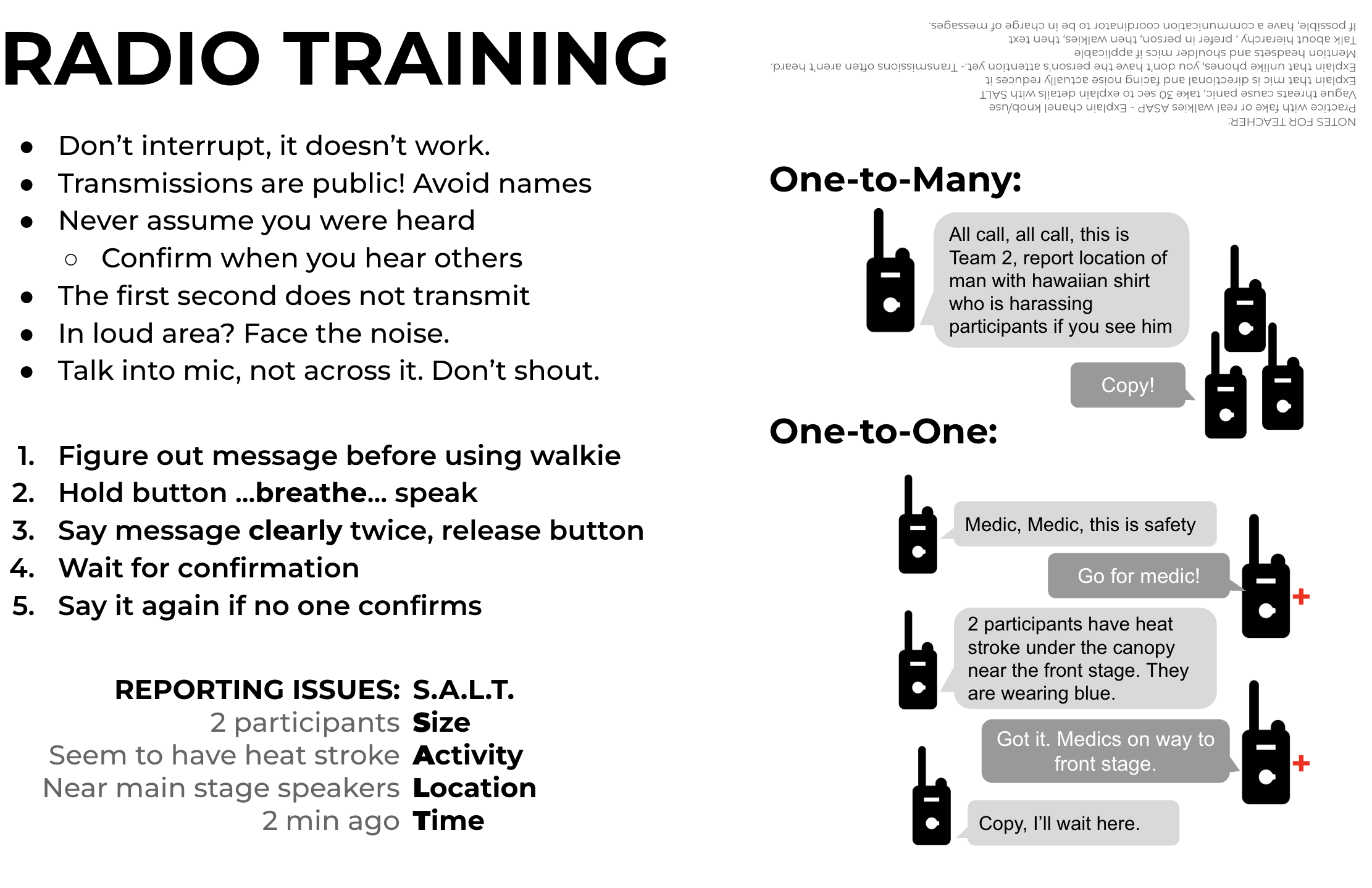Radio Training Tips
- Don’t interrupt, it doesn’t work.
- Transmissions are public! Avoid names
- Never assume you were heard
- Confirm when you hear others
- The first second does not transmit
- In loud area? Face the noise.
- Talk into mic, not across it. Don’t shout.
- PRACTICE with fake or real walkies ASAP
- unlike phones, you don’t have the person's attention yet
- Communication hierarchy , prefer in person, then walkies, then signal group
Basic Step By Step
- Figure out message before using walkie
- Hold button ...breathe... speak
- Say message clearly twice, release button
- Wait for confirmation
- Say it again if no one confirms

VAGUE THREATS CAUSE PANIC, TAKE 30 SEC TO EXPLAIN DETAILS with SALT
Shoulder Mics and Headsets
You must keep the shoulder mic (both a speaker, a mic, and a push-to-talk button) very near your ears. Otherwise you will not hear anything in a loud protest environment.
The jack on the walkie is obscure, but there is a standard headphone jack on the shoulder mic if you are on the sound truck or transmissions are expected to be sensitive. Single earphones are avaialble.

Our fleet
We have 30 bf888 and 12 GA-2s and more avaialable. More than 100 are available in the community for larger actions, but training is key to keep them useful with large numbers of users. Roles: communications coordinator
Most people are not very expericned with using walkies.People will make unclear transmissions, say things no one needs to know, and say things while they don’t have the intention of the recipient.
Some messages on the signal group will be urgent, and need to be conveyed by walkie. Some messages on the walkie will be complex and need to be conveyed by signal group.
The Communications Coordinator has the role of
- Replying copy for transmissions that were clear
- Replying “say again” for things that were not
- Repeating things that are crucial
- relaying things between the signal group and the walkie channel
- Ensuring specific people get specific messages, sometimes walking to find them
- If multiple channels are in use, they have multiple walkies
- If there is a sound truck or follow car, this is a great role to combine with co-pilot since stop start and speed changes can be communicated quickly and the inside of a car is quiet
🛒Details on choosing walkies to buy 🛒
Ignore this if you aren’t shopping :-)FRS is the common system most walkies use, and doesn’t require a permit. GMRS is less busy and longer range. Both are considered UHF.
Privacy codes will not keep your conversation private, and may make it impossible to notice if you are on a shared channel, sometimes casuing failed messages. Either keep them off, or be sure to make some noise on the channel and then use the monitor function to see if theres other on the channel that you normally cannot hear because of “privacy codes”
Cheap radios work ok,
The new Baofeng WP31 seems better (USB charging, waterproof) but the BF-888s are ~$15 each and high power and can be USB programmed(special cable) to custom channels, including some that are always vacant because of licening rules. They also don’t have as many buttons so it is harder for someone to accidentaly land on a channel alone. Email us for more info on this. We can also share our channel configuration
If $80/ radio is possible, there are some digital radios like the rt81 or rt50 with better range and that offer encryption. In protest environments, headsets or shoulder mics or keeping the whole radio on your shoulder is critical, or else no one will hear anyones messages.